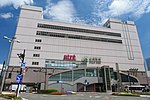Shinagawa
ShinagawaUse mdy dates from December 2020Wards of Tokyo

Shinagawa (品川区, Shinagawa-ku) is a special ward in the Tokyo Metropolis in Japan. The Ward refers to itself as Shinagawa City in English. The Ward is home to ten embassies. As of 1 April 2016, the Ward had an estimated population of 380,293 and a population density of 16,510 persons per km2. The total area is 22.84 km2.Shinagawa is also commonly used to refer to the business district around Shinagawa Station, which is not in Shinagawa Ward. This Shinagawa is in the Takanawa and Konan neighborhoods of Minato Ward, directly north of Kita-Shinagawa.
Excerpt from the Wikipedia article Shinagawa (License: CC BY-SA 3.0, Authors, Images).Shinagawa
Ikegami-dori, Shinagawa Oi
Geographical coordinates (GPS) Address Nearby Places Show on map
Geographical coordinates (GPS)
| Latitude | Longitude |
|---|---|
| N 35.6 ° | E 139.73333333333 ° |
Address
西光寺
Ikegami-dori
140-0014 Shinagawa, Oi
Japan
Open on Google Maps











